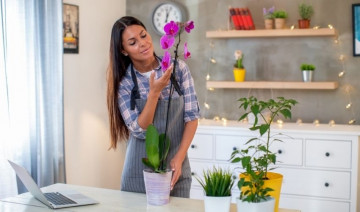
How to Care for Orchids
Orchids are elegant, exotic flowers that can add a burst of color and flair to any room. But do you know how to care for orchids so they will thrive and look their best? Orchids can be challenging houseplants, but with care and consideration, anyone can grow beautiful orchids.
About Orchids
There are more than 25,000 natural orchid species in the world, and more than 100,000 hybrids and cultivars that have been developed over centuries of orchid breeding and experimentation. All orchids belong to the family Orchidaceae, and orchid ancestors first evolved more than 80 million years ago. This is the largest and most diverse flowering plant family in the world, and orchids are found in nearly all global habitats, though they are absent from the harshest glacial regions. The greatest orchid diversity is found in tropical regions, with hundreds of different orchids found in Asia, Africa, and South America.
Today, there are hundreds of orchid societies, clubs, and enthusiast groups around the world, bringing orchidists together to share their joy in these amazing flowers. Orchids have been pictured in art, featured in poetry, and are even honored as official national flowers in Costa Rica, Honduras, Belize, Guatemala, and Panama. These flowers have captured attention and admiration around the globe, and anyone can bring orchids right into their homes with a bit of thoughtful care to meet these flowers’ needs.
Orchid Care Basics
Orchids can be somewhat finicky, and if you hope to grow one particular variety of orchid, it is best to research the specific needs of that individual flower. In general, however, most orchids share some similar needs, and understanding those care guidelines can help you provide the best environment for flourishing orchids.
- Use Proper Pots
In their native habitats, wild orchids may be attached to trees or rocks, while some varieties do grow from the soil. Using pots for growing orchids is for our own convenience, and small, clear or translucent pots that can show the moisture level and root growth are best so the flowers can be more easily monitored. Pots should have good drainage as well.
- Choose Specialized Orchid Potting Mix
Because these flowers need superior drainage and airflow to the roots, orchid potting mixes generally have greater amounts of moss, perlite, coir, or other materials to nurture orchids without smothering the roots. You can also blend your own potting mix from appropriate materials to create a customized growing medium for your orchids.
- Provide Ample Humidity
Most orchids have evolved in tropical environments with much higher humidity than we find in our homes. For these flowers to look their finest, they will need greater humidity, which can be provided with pebble trays, humidifiers, or greenhouse settings. Grouping several orchids together can also help them share humidity and create a lush, tropical setting.
- Encourage Some Air Movement
Orchids don’t like still air, which can foster pest infestations, fungus, and other difficulties. Position orchids where they will enjoy some air circulation, but it should not be so breezy that the flowers dry out too quickly or the humidity is compromised. Avoid placing orchids near heating ducts, air conditioning vents, or doors that are frequently opened.
- Provide Bright, Indirect Light
Orchids need adequate light to produce their beautiful blooms, though the exact lighting needs vary depending on the orchid species. Bright, indirect light is best, but the flowers can also be supplemented with broad spectrum fluorescent bulbs as needed, particularly in winter when days are short and natural light may be lacking.
- Keep Temperatures Appropriate
Because these are generally tropical flowers, most orchids need temperatures that range from the 60s to the 80s (Fahrenheit). Cooler nighttime temperatures can help keep these flowers on their natural, fluctuating rhythm. If proper temperatures may not be possible, consider keeping orchids in a greenhouse setting or other more highly controlled environment.
- Water Properly
Orchids don’t like wet roots, and they shouldn’t be watered too frequently. Saturating the roots under a running sink will give them that tropical watering feel, but orchids should be dried out between waterings so they don’t get waterlogged. Watering once a week is typically best for orchids, but less is often more with these flowers, so take care not to overwater.
- Fertilize as Needed
To keep their beauty, orchids need regular feeding, but it is important not to overfeed these flowers. A weak solution of specialized orchid fertilizer is best, and should be added to the flowers’ water once a week or every 10 days. Gentle feeding is best, or else the roots may burn and the orchids won’t survive.
- Watch for Pests
Just like any houseplants, orchids can be susceptible to mealybugs, scale, aphids, and other pests. Watch for these invaders closely, and immediately isolate any orchids that do get infested. Treating each pest with appropriate insecticidal soap or other proven means can help control infestations and keep them from spreading.
It can take experimentation and adjustment to find just the right balance of care for the most beautiful orchids. By understanding how to care for orchids properly, you can easily adjust their care and soon you will find yourself surrounded by these amazing flowers.

